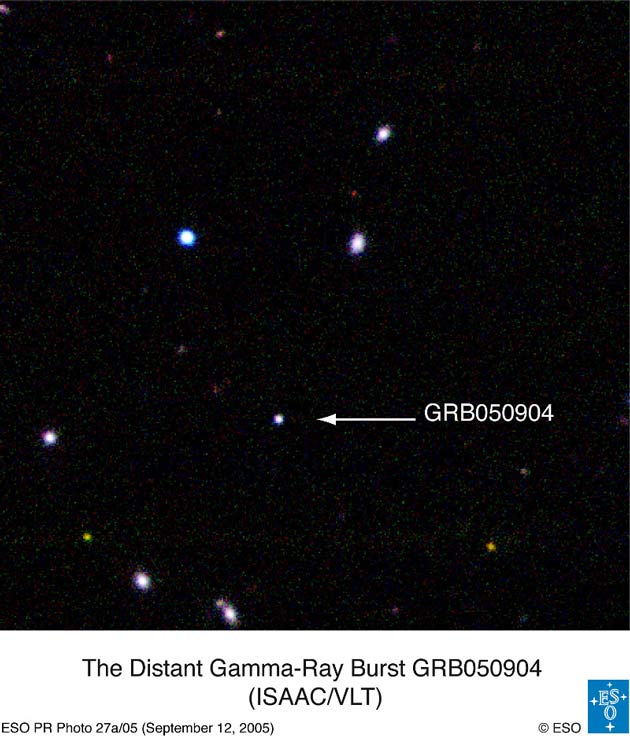
A team of internationalresearchers announced today the detection of the farthest space explosion everrecorded, breaking the previous record by 500 million light-years.
Known as gamma-ray bursts(GRBs), the eruptions are giant flares of energetic gamma-rays that can lastfrom less than a second to several minutes. They were accidentally discoveredin 1967 by sentry satellites monitoring for breeches of the nuclear test bantreaty.
GRBs signal the explosionof very massive stars that have collapsed into black holes and are the mostexplosive events to happen in the Universe since the Big Bang.
"It's luminosity is suchthat within a few minutes it must have released 300 times more energy than theSun will release during its entire life of 10,000 million years," saidGuido Chincarini, a researcher from the INAF-Osservatorio Astronomico di Breraand leader of the Italian team.
Astronomers believe shortGRBs that can last for only fractions of a second are generated when twomassive objects, like blackholes or neutron stars or even whole galaxies, collide, releasingtremendous amounts of radiation in the process.
The longer bursts, whichcan last for several minutes, are thought to be the final energetic emissionsof massive stars that first undergo tremendous explosions called supernovas beforecondensing into black holes.
Researchers calculatecosmic distances by measuring the extent to which light from distant stars are"shifted" towards the red part of the electromagnetic spectrum. Thehigher the redshift, the greater the distance.
Get the Space.com Newsletter
Breaking space news, the latest updates on rocket launches, skywatching events and more!
The new GRB has a redshiftof 6.29, meaning that it occurred when the universe was less than a billionyears old. The previous most distant GRB had a redshift of 4.5.
"This is unchartedterritory," said Daniel Reichart, an astronomer from the University ofNorth Carolina and the leader of the US team. "We are finally starting tosee the remnants of some of the oldest objects in the universe."
GRB 050904, as the new GRBis called, was detected by a joint US/UK/Italian telescope project called Swift.Launched last winter, Swift is designed to automatically detect the first flashof a GRB. Follow-up observationsrecorded the event in other wavelengths of light.
"We designed Swift tolook for faint bursts coming from the edge of the universe," said NeilGehrels, the Swift principal investigator from NASA Goddard Space FlightCenter. "Now we've got one and it's fascinating. For the first time we canlearn about individual stars from near the beginning of time."
Once a flash is detected,Swift notifies astronomers worldwide via e-mail, websites and even textmessages to mobile phones.
During a time when newgalaxies and stars were still being born, distant GRBs like the one recentlydetected were already ancient and in their final death throes. Astronomers cantherefore use GRB's to better understand physical conditions of the very earlyuniverse and the evolution of stars.
- Catching Cosmic Bangs: NASA's Swift Observatory to Hunt for Gamma-Ray Bursts
- Gamma Ray Bursts: Solving a Cosmic Riddle
- Powerful Space Bursts Reflect Two Ways to Make Black Holes
Join our Space Forums to keep talking space on the latest missions, night sky and more! And if you have a news tip, correction or comment, let us know at: community@space.com.
Ker Than is a science writer and children's book author who joined Space.com as a Staff Writer from 2005 to 2007. Ker covered astronomy and human spaceflight while at Space.com, including space shuttle launches, and has authored three science books for kids about earthquakes, stars and black holes. Ker's work has also appeared in National Geographic, Nature News, New Scientist and Sky & Telescope, among others. He earned a bachelor's degree in biology from UC Irvine and a master's degree in science journalism from New York University. Ker is currently the Director of Science Communications at Stanford University.









